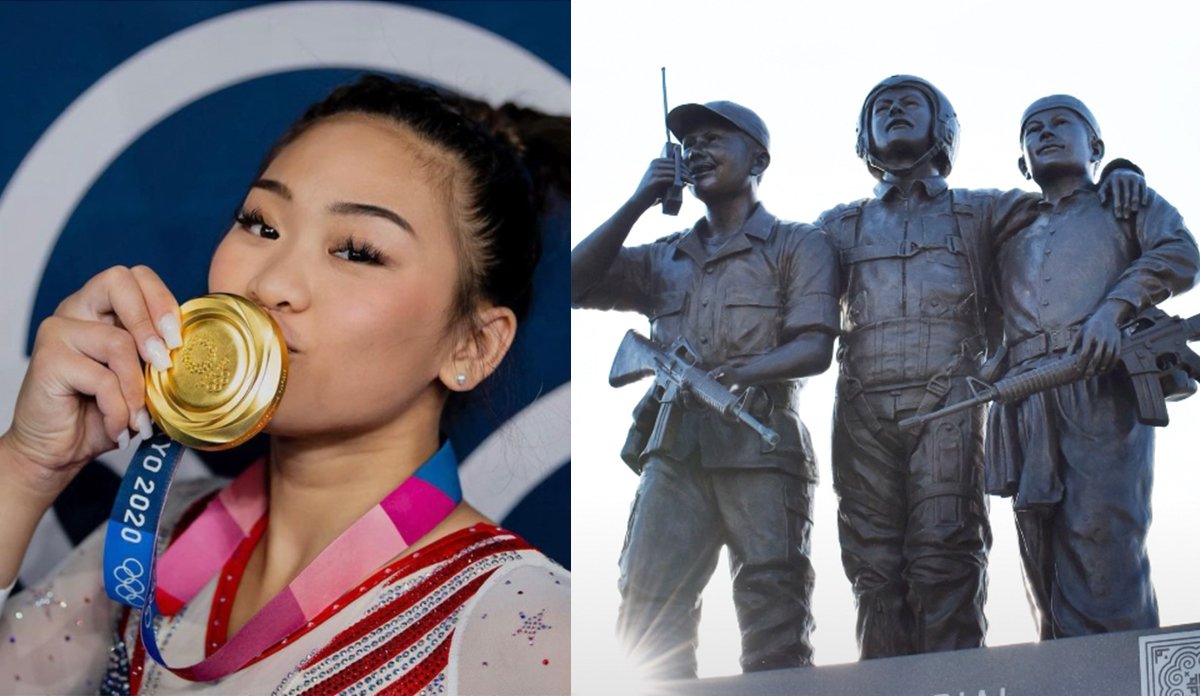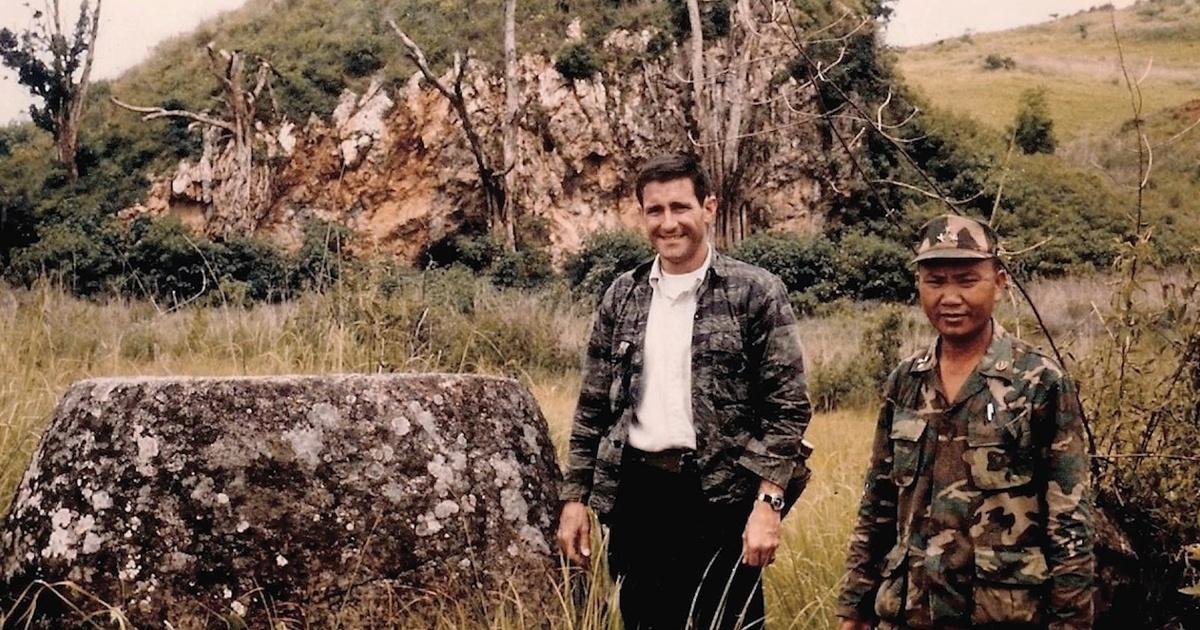Sunisa Lee’s Olympic Gold Celebrated by Hmong Americans, Forgotten Allies in Vietnam War

Hmong American Sunisa Lee’s all-around gold medal at the Tokyo Olympics has cast a spotlight on the Hmong American community, which traces its roots to largely forgotten allies of US soldiers in the Vietnam War. Right, the Hmong-Lao Veterans Memorial statue in Wausau, Wisconsin. Photos courtesy of Instagram and YouTube.
Sunisa Lee, an 18-year-old Hmong American, took gold in the 2020 Tokyo Olympics women’s gymnastics all-around event on Thursday. With her victory, Lee became the first Hmong American to win an Olympic medal. In coverage of the Games, Lee’s performances were often cut with videos of her hometown fans in Minnesota. As her success grew, the crowds in the clips grew too, as the Hmong American community in St. Paul rallied to her side.
The city is a hub for the US Hmong community, which traces its beginnings to a 1970s immigration wave after the Vietnam War. Those Hmong families came to St. Paul and a few other cities, such as Fresno, California, fleeing persecution after Hmong soldiers fought beside American forces in Vietnam for much of the war.
Below: The mostly Hmong American crowd, including Sunisa Lee’s family, gathered in St. Paul, Minnesota, to watch her compete.
Sunisa Lee is going to win the gold medal in all-around. Unbelievable. pic.twitter.com/C8sfKMmfc4
— Dane Mizutani (@DaneMizutani) July 29, 2021
Hmong soldiers were among the United States’ most ardent allies in the war, enlisted by the CIA in the so-called Secret War in Laos. They mainly fought alone and in secret, defending secret American bases, rescuing US pilots, and disrupting North Vietnamese supply lines. Hmong fought with Americans for the entirety of the war, from 1960 to 1975.
“One Hmong that died in Laos meant one American [fighting in] South Vietnam going home,” said Lee Pao Xiong, director of the Center for Hmong Studies at Concordia University. “We prevented the North Vietnamese Army from going into South Vietnam to massacre the Americans down there.”

In the 1960s and 1970s, the CIA trained and equipped thousands of Hmong soldiers in northern Laos to conduct covert operations against communist forces. The Hmong soldiers were given three-day crash courses in guerrilla tactics before entering combat as members of the Special Guerrilla Units, or SGUs.
These SGUs had three primary missions behind enemy lines on behalf of the CIA and the US military. They were to protect the secret American radar base, Lima Site 85, the site of one of the war’s fiercest battles and rescue missions, though its details remained secret for decades; rescue American pilots shot down near the border of Laos and Vietnam; and disrupt the flow of North Vietnamese supply lines on the Ho Chi Minh Trail.
Kiachue Xiong, one Hmong soldier who later moved to Sacramento, California, served in the SGUs from 1960 to 1975 and was shot and blown up during the years of fighting. He still has more than 50 pieces of shrapnel in his body.
More than 35,000 Hmong soldiers were killed in action or declared missing, and others lost their lives attempting to escape to freedom after the US withdrew — a retreat that many Hmong still view as the US abandoning them. Although they were hired and paid by the CIA, the Hmong are not recognized as US veterans, seen simply as surrogates.
Even today, CIA veterans of the Secret War speak out about the bravery of the Hmong they fought with and the cold reality that the US abandoned the Hmong people when it left.
“For 10 years, [Royal Lao Army Gen.] Vang Pao’s soldiers held the growing North Vietnamese forces to approximately the same battlelines they held in 1962,” William E. Colby, the CIA director from 1973-1976, said in a speech in 1996. “And significantly for Americans, the 70,000 North Vietnamese engaged in Laos were not available to add to the forces fighting Americans and South Vietnamese in South Vietnam.”
Below, a Department of Defense documentary of the Lima Site 85 battle, which included over 1,000 Hmong soldiers fighting with a handful of Americans.
After the American withdrawal, the Hmong faced persecution and massacres similar to the better-known mass murders committed by the Khmer Rouge in Cambodia. In 1975, when the communist group Pathet Lao threatened to capture Laos, the CIA would only allow the evacuation of some 2,500 high-ranking military officers and their families. The Pathet Lao launched an aggressive and targeted kill campaign against all Hmong soldiers who had sided with the Americans. Those who could fled to refugee camps in Thailand; others took refuge in the jungle to fend for themselves.

Even Yang See, a liaison between the CIA and the Royal Lao Army, a reliable CIA asset known by the radio call sign “Glass Man,” had to use his own money to ensure safe harbor for hundreds of refugees. Still, the Hmong people weren’t considered suitable for resettlement in the United States at first.
“The U.S. considered the Hmong to be ‘illiterate’ and ‘people living in the hills’ who would not be able to adjust to modern life in America,” Yang Dao, a former Laotian official, said, according to Minnesota Public Radio News.
The first Hmong family to resettle in Minnesota came over in November 1975. After the passage of the US Refugee Act of 1980, the largest wave of refugees arrived in Minnesota. It took decades before “the last wave” finally resettled in America, and by 2010, the Hmong American community had grown to 260,000.
“Here were thousands of Hmong, many of whom spoke American military lingo and had names like ‘Lucky’ and ‘Judy’ and ‘Bison’ and who had been soldiers, radio operators, pilots, and CIA operatives in a war unknown to the American public,” Lionel Rosenblatt, head of the Refugees International, said, according to Larry Clinton Thompson’s Refugee Workers in the Indochina Exodus, 1975-1982. “If the United States owed gratitude to anyone in Southeast Asia, it was the Hmong.”
Read Next:

Matt Fratus is a history staff writer for Coffee or Die. He prides himself on uncovering the most fascinating tales of history by sharing them through any means of engaging storytelling. He writes for his micro-blog @LateNightHistory on Instagram, where he shares the story behind the image. He is also the host of the Late Night History podcast. When not writing about history, Matt enjoys volunteering for One More Wave and rooting for Boston sports teams.
BRCC and Bad Moon Print Press team up for an exclusive, limited-edition T-shirt design!
BRCC partners with Team Room Design for an exclusive T-shirt release!
Thirty Seconds Out has partnered with BRCC for an exclusive shirt design invoking the God of Winter.
Lucas O'Hara of Grizzly Forge has teamed up with BRCC for a badass, exclusive Shirt Club T-shirt design featuring his most popular knife and tiomahawk.
Coffee or Die sits down with one of the graphic designers behind Black Rifle Coffee's signature look and vibe.
Biden will award the Medal of Honor to a Vietnam War Army helicopter pilot who risked his life to save a reconnaissance team from almost certain death.
Ever wonder how much Jack Mandaville would f*ck sh*t up if he went back in time? The American Revolution didn't even see him coming.
A nearly 200-year-old West Point time capsule that at first appeared to yield little more than dust contains hidden treasure, the US Military Academy said.












